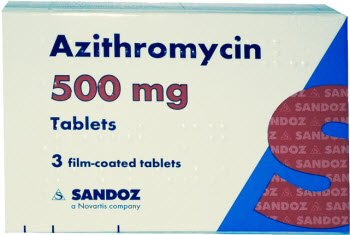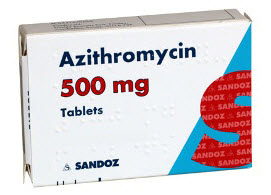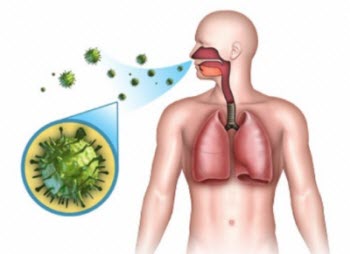
Zithromax Information. Clinical and pharmacological characteristics of Zithromax (Azithromycin) as a basis for the effectiveness of short courses of antibiotic therapy
Zithromax (Azithromycin) remains today one of the preferred antibiotic for the treatment of infections of the upper and lower respiratory tract.
It is highly active against the most likely bacterial pathogens of respiratory infections.
Zithromax (Azithromycin) has unique, the longest compared to other antibacterial drugs half-life of 68 hours on average, and has a very high affinity for the fabric. [9] In contrast to the beta-lactams and aminoglycosides, which is due to clinical efficacy ratio values of minimum inhibitory concentration (MIC) of an antibiotic for a particular microorganism, and this level of concentration of the antibiotic in the blood, the effectiveness of azithromycin depends on the level of drug concentration in the tissues.
This significant clinical effect of azithromycin is observed at relatively low values of azithromycin concentration in blood with respect to the MPK90 to abjection. For example, for sensitive to azithromycin strains S. pneumoniae (MIC <0.5 mg / l) concentration in the blood exceeds the MIC for this agent only for a short period after receiving the dose of antibiotic. Despite this, in the appointment of the drug reached the optimal clinical and microbiological performance indicators (completeness bacterial eradication from the source of infection) [10, 11]. This dissociation is determined by the fact that azithromycin quickly leaves the systemic circulation and is concentrated in polynuclears, monocytes, lymphocytes, alveolar macrophages, fibroblasts, creating in them a concentration exceeding 80 mg / l [11].
When migration to the inflammatory focus phagocytes perform the transport function and deliver the antibiotic directly to the site of localization of bacteria in diseased, infected tissue, which allows you to create high and long-term persistence of the concentration of azithromycin is in the focus of infection. The concentration of the antibiotic in the foci of infection was approximately 24-36% higher than in healthy human tissues [12, 13].
Due to the nature of its chemical structure of Zithromax (Azithromycin) is concentrated in the "acidic" organelles, lysosomes membrane phospholipid layer of phagocytic blood cells (neutrophils, monocytes) and tissues (alveolar macrophages).
Once in the acidic environment of azithromycin molecule alters the electrical charge and can not freely pass through the membrane. Due lysosome fusion (accumulation place of the antibiotic in the cell) with phagocytes containing the captured bacteria, the formation of blood cells in phagolysosomes. Once inside phagolysosome, an antibiotic like "locked" and there goes back very slowly. Through this mechanism, "tissue kinetics", the main part of the dose of the drug, the patient received, quite quickly (through the intestine, bloodstream, the extracellular space, the plasma membrane, cytoplasm) is flagged fagolizomosy, which is exactly in the spot where the pathogens are. In the phagolysosome antibiotic is able to effectively attack the bacteria absorbed, but not destroyed by phagocytes. This high concentration and long-lasting formulation allows us to consider it "independent of concentration in the blood killer", which is very important for its rational clinical use.
Such targeted delivery of antibiotics is of particular importance in the case in restricted loci of infection, and for the eradication of intracellular pathogens. Significant accumulation of Zithromax (Azithromycin) observed in lung tissue, fluids lining the mucosa bronchi and alveoli, the bronchial secretions, saliva, tonsils, middle ear, sinuses, mucous membrane of the gastrointestinal (GI) tract, prostate, conjunctiva and eye tissues, skin, bile , urethra, uterus, appendages and the placenta. [9] Described "tissue kinetics" is confirmed by the data obtained using bronchoscopic techniques. It is shown that the maximum concentration of Zithromax (Azithromycin) after receiving a single dose of 500 mg up sputum for 1.56 mg / L, the bronchial mucosa - 3.89 mg / kg, interstitial lung liquid - 2.18 mg / l, alveolar macrophages - 23 mg / kg. Meanwhile, drug concentration in the blood at this point is 0.3-0.5 mg / l. Part of azithromycin may be released from macrophages, neutrophils and monocytes during phagocytosis by the action of bacterial stimuli in and out the blood and intercellular fluid.
Then, after some time of blood or drug can be re-captured by the body's tissues by immunocompetent cells and return them to the center of infection, re-joining in phagolysosome and destroying pathogens. There is a recycling effect, targeted "swap" of the antibiotic in the focus of infection from the blood and the surrounding tissues. It is important that the interstitial circulation of the antibiotic can last up to 10 days and does not require the introduction of new doses of the drug into the body from the outside, and that determines the possibility of a short, 3-day course of antibiotic therapy.
Thus after 4-7 days after the last (third) dose of azithromycin its intracellular concentration is more than 32 mg / l, which is much greater than the MIC for pathogens (particularly S. pneumoniae MIC of less than <0.5 mg / l ). Similar relations intracellular concentrations of the drug and the IPC for the other agents. The presence of azithromycin in tissues, immune cells in patients with such high relative to most target pathogens MPK90 over time defines the lower risks of drug resistance, optimizes and intensifies the antibacterial effect against cocci, H. influenzae, S. pneumoniae located intracellularly, C . trachomatis, Mycoplasma pneumoniae, and others. [14]. In addition to the antimicrobial action, Zithromax (Azithromycin) accumulates in tissues, has anti-inflammatory, immunomodulating properties [15].
Effects of azithromycin on the immune system begins with a vast influence on the diapedesis of activated leukocytes into lipopolysaccharide bacterial infectious focus.
This reduces excess tissue induration that may later lead to the affected organ tissue replacement by connective tissue [16]. The drug can inhibit the activity of free radical oxidation, inhibits proinflammatory cytokines - interleukin-1 (IL-1), IL-6, IL-8, tumor necrosis factor, increases expression of inflammatory mediators [17]. Creating a high concentration in the cells, phagocytes, Zithromax (Azithromycin) stimulates chemotaxis and phagocytosis [18]. Inhibition of IL-8, azithromycin reduces transendothelial migration of neutrophils and monocytes [19]. The drug causes degranulation of neutrophils [20], the proof of which is to increase the level of lysosomal enzymes in the blood plasma and a decrease in their activity in macrophages after the first dose of azithromycin. After a course of antibiotic therapy (500 mg Zithromax (Azithromycin) daily for 3 days), the level of enzymes in blood is a time high, and simultaneously - to feedback - the accumulation of granules in neutrophils providing anti-infective rollover protection. In addition to the clinical data, these results are biochemical evidence sufficiency 3-day course of Zithromax (Azithromycin) therapy.
Simultaneously with increased levels of lysosomal enzymes induced chemotaxis of macrophages - purposeful movement toward the source of infection [21]. Thus, there is a significant increase in anti-infective barrier through new pools involving leukocyte activation and their functions.
A distinctive feature of the action of Zithromax (Azithromycin) is the stimulation of "oxidative explosion" in macrophages - the oxygen consumption required to produce energy and the implementation of macrophage functions.
This effect is sufficiently long and provides the activation of phagocytes. At the same time, this effect fades away, without causing damage to the bronchial epithelium [22]. This so-called "early response" immunomodulation inherent only Zithromax (Azithromycin). Macrolides restore the balance of T-helper cells of various types and maintain their functions [23, 24]. This effect is of great importance for the regulation of the synthesis of pro-inflammatory cytokines, reducing the pressure on the host cell, reducing swelling and preventing the formation of stagnant lymphocytic induration.
The important is not only the stimulation of the immune defense, but also the cessation of immunity activation lower infection. It is noted that after the reorganization Zithromax (Azithromycin) infection has actually stops unwanted immune response by activating apoptosis (biologically programmed death) of neutrophils [25]. It inhibits processes of local damage and prevents the involvement of host cells in the immune response. The described effect is demonstrated in volunteers and patients with community-acquired pneumonia caused by Streptococcus pneumoniae [26].
The antibiotic has also mucoregulatory effect, exerting a beneficial effect on the clearance of bronchial and nasal secretions [2].
Zithromax (Azithromycin) is currently one of the safest antimicrobial drugs.
According to a meta-analysis that included 45 clinical studies, the incidence of adverse events while taking Zithromax (Azithromycin) was 8.7%, the most typical of which were violations of the gastrointestinal tract - the pain and discomfort in the abdomen, nausea, diarrhea [27]. In another meta shown that azithromycin frequency cancellation due to adverse events in the treatment of infections of the upper and lower respiratory tract was 0.7% and 0.8%, respectively [28]. When Zithromax (Azithromycin) intravenous infusion was better tolerated than erythromycin and clarithromycin. According to the safety of azithromycin in pregnant relates to preparations with an unlikely risk of toxic effects on the fetus - category B (on the classification of the Office of the Food and Drug US funds (Food and Drug Administration, FDA)).
Thus, despite nearly 30 years of clinical use of Zithromax (Azithromycin) remains today one of the preferred antibiotic for treatment of infections of different localization. It is highly active against the most likely pathogens of bacterial respiratory infections, including intracellular pathogens and Haemophilus influenzae. Acquired resistance to microbial azithromycin in Russia remains low during the entire period of its application. Unique pharmacokinetics, with the accumulation of high concentrations in tissues, immune cells, and long half-life of the drug from the body allow to use azithromycin 1 day in a short time of 3-day course. In this comparative clinical efficacy and safety of azithromycin for respiratory tract infections is not inferior to that of 7-10-day course of antibiotics alternative that is proven in numerous clinical studies.








